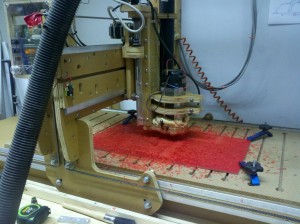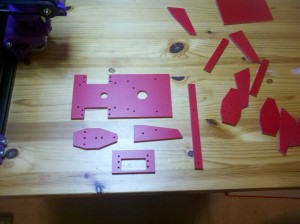Working in 2D: Using a CNC Mill
I have been enjoying the 3D printer. It’s very easy to go on Thingiverse and download toys and objects to print. My ultimate goal, though, is to design my own parts for the machines I want to build. And that means learning computer-aided design (CAD) software. There are quite a few of these around for hobbyists: SketchUp and OpenSCAD for example. But generally I hadn’t fallen in love with any of them. They were either imprecise or hard to use with complex objects.
In my continuing search I came across a great free program: DraftSight. It’s made by the same company that own SolidWorks, a premiere (and extremely expensive) software CAD package. DraftSight has one key limitation, it can only do 2D. Still, this seemed a reasonable place to start, especially as so many 3D objects are simple extrusions of a 2D design. And I thought this would be a good excuse to finally make something on the Nova Labs laser cutter, which can cut out precision pieces from a number of materials.
For project ideas, I turned to the Robot Builder’s Bonanza. I’d seen the Hexbot robot in there and thought it would be a cool, straightforward build. I’ve always wanted to make something that walked instead of rolled. The author Gordon McComb suggests working with expanded PVC, also known as Sintra. It has most of the advantages of wood while appearing in bright colors and very uniform, which makes it easy to machine. I had used this material as a base for FireCheetah and it had attracted favorable comments. I ordered a slab and started designing.
The software worked very well and it was good to finally have a program where I could type in exact dimensions (Inkscape, the recommended program for the laser cutter, sadly lacking there). The design phase went quickly. When I went to cut, however, I discovered a problem; PVC cannot be used in a laser cutter as it gives off chlorine gas. I already knew that the laser cutter could not handle metal, either, which was a great disappointment.
Fortunately, Nova Labs has a nice, large, CNC mill. CNC stands for “computer numberical control” and a CNC mill is one of the classic machine tools. To quote from the ShopBot site, a CNC mill:
is an amazing do-all tool for precisely cutting, carving, drilling or machining all kinds of things from all kinds of materials. You use the included software to design your parts on your personal computer, then, like a robot, the computer controls the cutter to precisely cut your parts.
A CNC mill is a perfect compliment to a 3D printer. The 3D printer is an additive machine, creating parts by laying down material; the CNC mill creates parts by taking away material. And unlike the laser cutter or 3D printer, the CNC mill can work with almost any material. Clearly, a valuable tool to learn about.
The downside is that the learning curve is steeper than a laser cutter; when drill bits are involved the danger level rises and there are more variables to tune. And unlike the laser cutter, there were no training classes set up for it. Fortunately a fellow maker, Neil Moloney, was kind enough to show me the basics.
These are the robot pieces I cut:
The CNC mill drilled the screw holes and cut the edges beautifully. Far better than I could ever have done by the manual methods suggested in the book.
Ironically, though, when I went to put the pieces together I discovered that the original plans were flawed; there is not enough clearance for some nuts. I designed perfectly to a poor schematic. No tool can fix that! So in the end I will have to pull out my scroll saw and do a minor amount of manual trimming. Nevertheless the CNC mill is a fantastic tool and I’m looking forward to using it again.


>> I discovered that the original plans were flawed; there is not enough clearance for some nuts. I designed perfectly to a poor schematic. No tool can fix that!
Unfortunately, that’s my opinion for much of the material in McComb’s book. Its still a fun book though, and I’ve had lots of fun times trying stuff out. Glad to see you’re getting somewhere with your CNC Router! I’ve just built my first router and have been having a good time learning how to use it.